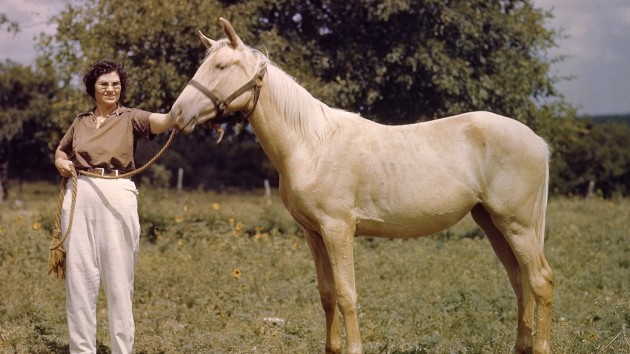
by Yona Zeldis McDonough
This Jewish Cowgirl Never Got the Blues

Photo courtesy of the Witte Museum
Question: What do Sandra Day O’Connor, Georgia O’Keefe, Patsy Cline, Annie Oakley and Frances Rosenthal Kallison have in common? Answer: They’re all inductees in the National Cowgirl Museum and Hall of Fame. And Kallison, who died in 2004 and was inducted posthumously, was the first Jewish woman ever to join these ranks.
A third-generation Texan and the only child of Mose A. Rosenthal and Mary Neumegan, Kallison was born in 1908 and grew up in Fort Worth, riding the horses that hauled her family’s furniture wagons. According to Hollace Ava Weiner, writing in the Western States Jewish History, “The city’s Jews were mostly haberdashers, liquor distributors, saloonkeepers, livery men, tailors, grocers and junkmen, although three of the founding fathers operated legitimate theaters.”
Young Frances went to synagogue first in a horse and wagon and then, because her mother was one of the first women in Fort Worth who learned to drive, a Studebaker. She excelled in school, and though Jewish was sent in her senior year to St. Mary’s College for Girls, an Episcopal school. From there, she went on to Vassar, but found their courses “limited” and was not happy. Her daughter, Bobbi, suggests that as a rough-hewn Texas gal she was not comfortable with the more urban—and snobbish—Jewish girls she met at Vassar. She transferred to the University of Chicago, from which she graduated in 1929 with a degree in economics. Although she had wanted to go into banking, the Depression effectively put an end to that dream, and in 1931, she married Perry Kallison in a Reform ceremony at San Antonio’s storied Menger Hotel.
As Mrs. Kallison, Frances was introduced to a new world. The Kallison family owned and ran a farm-and-ranch store that took up an entire city block. The Kallison ranch covered 2,700 acres and boasted show horses, prize-winning bulls and experimental crops. Though her family was well-off, Kallison could easily see that many of her neighbors were not, and she felt compelled to help. She became active in the San Antonio section of the National Council of Jewish Women—by 1938, she had become the local president.
This role gave her the opportunity for what turned into a lifelong pursuit of civic activism. She was instrumental in establishing a maternity ward at the Robert B. Green Hospital as well as the one of the city’s first well-baby and prenatal clinics. She vigorously opposed the $2.50 poll tax “because it kept the poor from voting.” She raised money for a variety of causes, and gave generously of her time and money.
Kallison also had a lifelong passion for local Jewish history, and devoted herself to studying and publicizing the role of Jews in the Lone Star state; in 1966 was appointed to the board American Jewish History. In 1968, she organized an ethnic Jewish exhibit at the Texas Pavilion of the Hemisphere, the world’s fair slated to open in San Antonio, and she followed that up with her provocative “Was it a Duel or a Murder: A Study in Texan Assimilation.” The article began with the inscription on a tombstone in San Antonio’s oldest Jewish cemetery. The inscription noted that the deceased died a violent death. Kallison pored over newspapers and diaries, trying to piece together the story. The article was published in 1972 in the American Jewish Historical Quarterly, the precursor to today’s American Jewish History journal and, according to Weiner, “brought Frances Kallison and Texas Jewish history onto a national stage.”
Throughout her long life, Frances remained an active partner in the Kallison family ranch, exercising horses, naming baby calves, keeping the breed books and registering bulls. Yet for all this boundary-breaking and gender-bending, Kallison’s daughter Bobbi says her mother would not have called herself a feminist, and wouldn’t dream of leaving the house without her white gloves; she was as comfortable in them as she was in her riding clothes.
Kallison was a Westerner and a Texan; geography helped determine her character and shaped the course of her life. It was her energy, determination, enormous decency and highly developed sense of social justice that brought her to the attention of National Cowgirl Hall Museum and Hall of Fame and her induction is a fitting and final honor for the life of this Jewish woman pioneer.
The views and opinions expressed in this article are the author’s own and do not necessarily reflect those of Lilith Magazine.